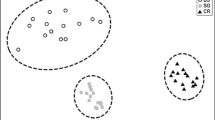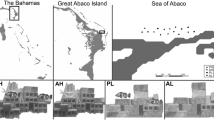Abstract
Patterns in juvenile mortality rates can have a profound affect on the distribution and abundance of adult individuals, and may be the result of a number of interacting factors. Field observations at Lizard Island (Great Barrier Reef, Australia) showed that for a coral reef damselfish, Pomacentrus moluccensis, juvenile mortality (over 1 year) varied between 20 and almost 100% among sites. Correlative data showed that juvenile mortality increased as a function of initial densities (recruitment), predator densities and the availability of preferred coral substrata. A multiple regression showed that these three variables together did not explain significantly more variation in mortality than the single factor showing the strongest relationship. This appeared to be because recruitment, predator densities and preferred coral substrata were all highly correlated, suggesting that one, two or all of these factors may be influencing juvenile mortality rates. One hypothesis was that density-dependent mortality in juveniles was the result of an interaction between predators (which appear to aggregate at high-recruitment sites) and the availability of preferred substrata (predator refuges). We tested this hypothesis by using both laboratory and field experiments to see whether fish predation could significantly alter survivorship of this damselfish, and whether this impact was dependent upon the coral substratum. The laboratory experiment was designed to test the effects of three common predators (Pseudochromis fuscus, Cephalopholis boenak and Thalassoma lunare) and three different coral substrata that varied in their complexity (Pocillopora damicornis, Acropora nasuta and A. nobilis) on the survival of juvenile Pomacentrus moluccensis. There was a significant interaction between predator species and microhabitat in determining survival. Pseudochromis fuscus and C. boenak were both significantly better at capturing juvenile damselfish than T. lunare. Juvenile survivorship was significantly better when they were given the more complex corals, Pocillopora damicornis and A. nasuta, compared with those given the open-structured species A. nobilis. This pattern reflects habitat selection in the field. Predators differed in their strike rates and the proportion of strikes that were successful, but all exhibited greater success at prey capture where A. nobilis was provided as shelter. The interaction between the effect of predator species and microhabitat structure on damselfish survival was tested in the field for a cohort of juvenile Pomacentrus moluccensis. We examined juvenile survival in the presence and absence of two predators that co-occur on natural patch reefs (C. boenak and Pseudochromis fuscus). The experimental patch reefs we used for this purpose were constructed from both high complexity (Pocillopora damicornis) and low complexity (A. nobilis) coral substrata. Both juveniles and predators were translocated to reefs at natural densities. The effects of predation were clearly dependent upon the microhabitat. Reefs of the high-complexity coral with predators supported the same high numbers of Pomacentrus moluccensis as the reefs with no resident predators. However, damselfish abundance was significantly lower on low-complexity reefs with resident predators, relative to the other treatments. Background rates of loss were high, even on preferred coral in the absence of the manipulated predator, suggesting that transient predators may be even more important than the residents. We suggest that adult abundances in this species were strongly influenced by the densities of different predators and the availability of preferred refuges.
Similar content being viewed by others
Author information
Authors and Affiliations
Additional information
Received: 3 April 1997 / Accepted: 26 August 1997
Rights and permissions
About this article
Cite this article
Beukers, J., Jones, G. Habitat complexity modifies the impact of piscivores on a coral reef fish population. Oecologia 114, 50–59 (1998). https://doi.org/10.1007/s004420050419
Issue Date:
DOI: https://doi.org/10.1007/s004420050419




